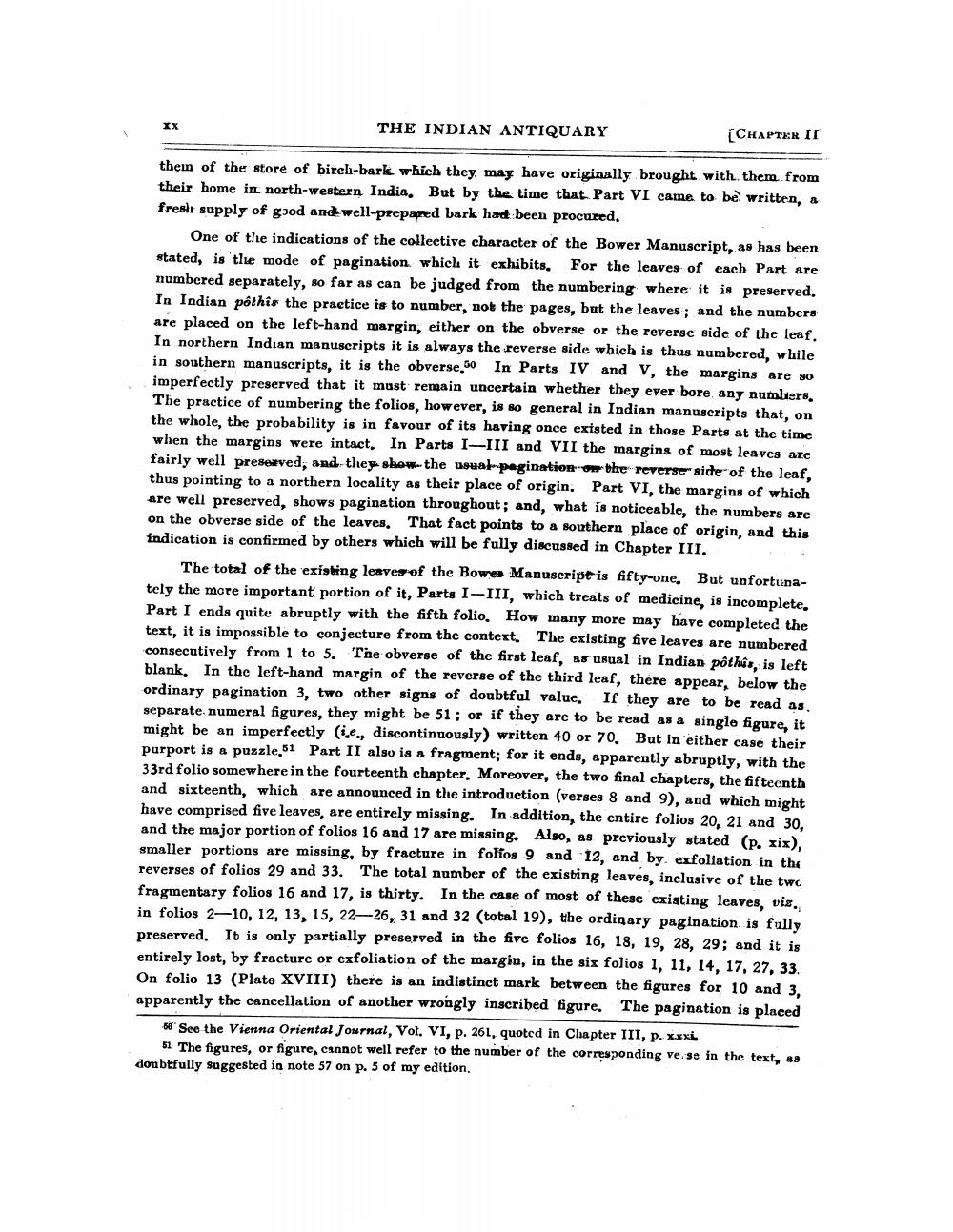________________
IX
THE INDIAN ANTIQUARY
CHAPTER II
them of the store of birch-bark which they may have originally brought with them from their home in north-western India. But by the time that Part VI came to be written, a fresh supply of good and well-prepared bark had been procured,
One of the indications of the collective character of the Bower Manuscript, as has been stated, is the mode of pagination, which it exhibits. For the leaves of each Part are numbered separately, so far as can be judged from the numbering where it is preserved. In Indian pôthis the practice is to number, not the pages, but the leaves; and the numbers are placed on the left-hand margin, either on the obverse or the reverse side of the leaf. In northern Indian manuscripts it is always the reverse side which is thus numbered, while in southern manuscripts, it is the obverse.50 In Parts IV and V, the margins are so imperfectly preserved that it must remain uncertain whether they ever bore, any numbers. The practice of numbering the folios, however, is so general in Indian manuscripts that, on the whole, the probability is in favour of its having once existed in those Parts at the time when the margins were intact. In Parts I-III and VII the margins of most leaves are fairly well preserved, and they show the usual pagination on the reverse side of the leaf, thus pointing to a northern locality as their place of origin. Part VI, the margins of which are well preserved, shows pagination throughout; and, what is noticeable, the numbers are on the obverse side of the leaves. That fact points to a southern place of origin, and this indication is confirmed by others which will be fully discussed in Chapter III.
The total of the existing leaves of the Bowes Manuscript is fifty-one. But unfortunately the more important portion of it, Parts I-III, which treats of medicine, is incomplete, Part I ends quite abruptly with the fifth folio. How many more may have completed the text, it is impossible to conjecture from the context. The existing five leaves are numbered consecutively from 1 to 5. The obverse of the first leaf, as usual in Indian pôthis, is left blank. In the left-hand margin of the reverse of the third leaf, there appear, below the ordinary pagination 3, two other signs of doubtful value. If they are to be read as separate. numeral figures, they might be 51 ; or if they are to be read as a single figure, it might be an imperfectly (ie., discontinuously) written 40 or 70. But in either case their purport is a puzzle,51 Part II also is a fragment; for it ends, apparently abruptly, with the 33rd folio somewhere in the fourteenth chapter. Moreover, the two final chapters, the fifteenth and sixteenth, which are announced in the introduction (verses 8 and 9), and which might have comprised five leaves, are entirely missing. In addition, the entire folios 20, 21 and 30, and the major portion of folios 16 and 17 are missing. Also, as previously stated (p. xix), smaller portions are missing, by fracture in folíos 9 and 12, and by exfoliation in the reverses of folios 29 and 33. The total number of the existing leaves, inclusive of the two fragmentary folios 16 and 17, is thirty. In the case of most of these existing leaves, vis. in folios 2-10, 12, 13, 15, 22-26, 31 and 32 (total 19), the ordinary pagination is fully preserved. It is only partially preserved in the five folios 16, 18, 19, 28. 29; and it is entirely lost, by fracture or exfoliation of the margin, in the six folios 1, 11, 14, 17, 27, 33. On folio 13 (Plate XVIII) there is an indistinct mark between the figures for 10 and 3. apparently the cancellation of another wrongly inscribed figure. The pagination is placed
50" See the Vienna Oriental Journal, Vol. VI, p. 261, quoted in Chapter III, P. xxxi
51 The figures, or figure, cannot well refer to the number of the corresponding ve.se in the text, 49 doubtfully suggested in note 57 on p. 5 of my edition.




